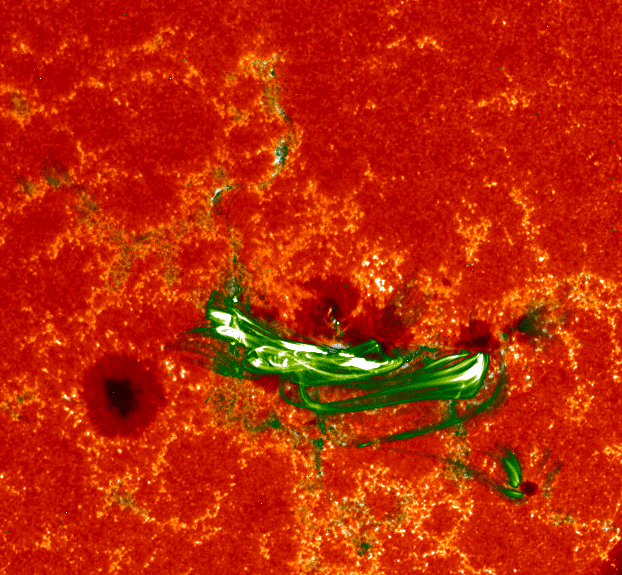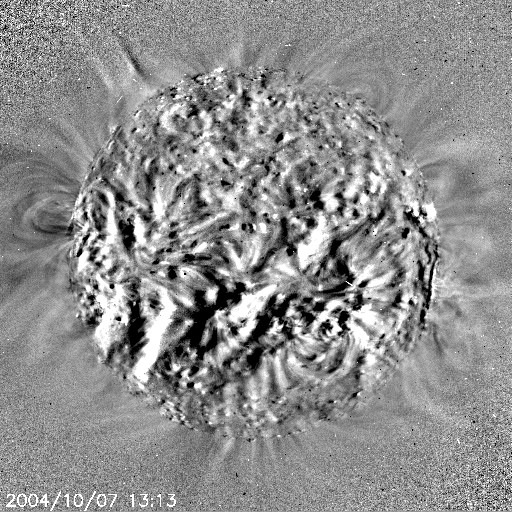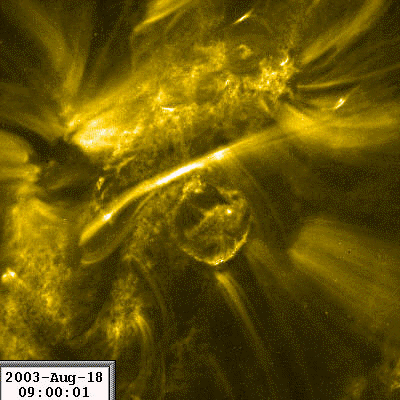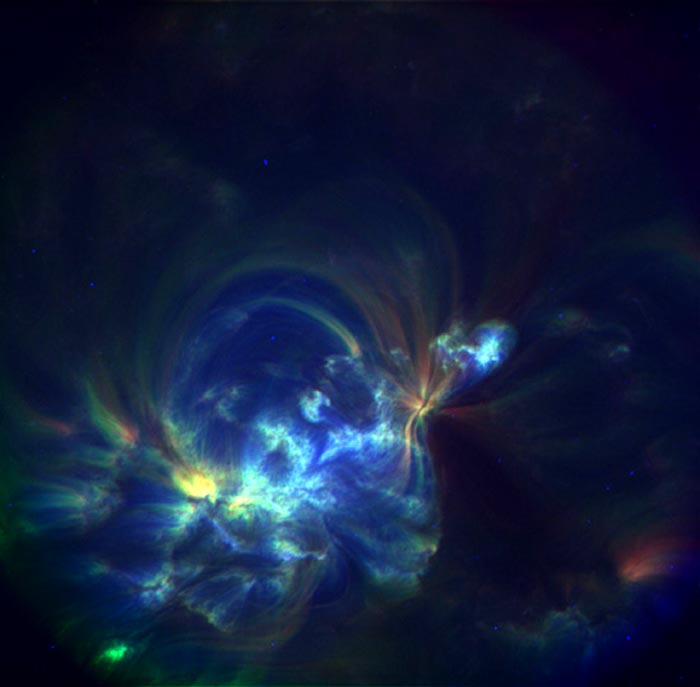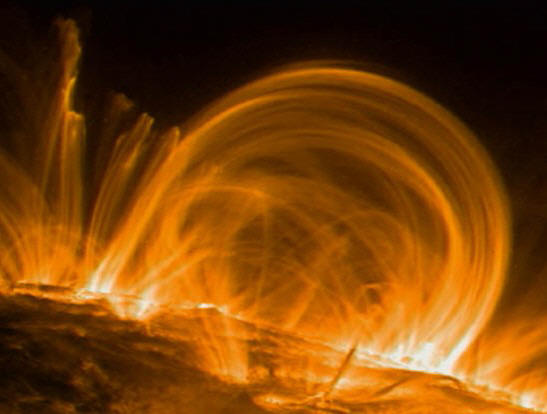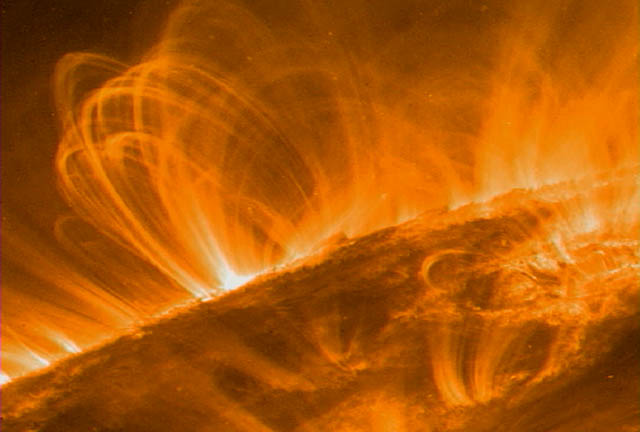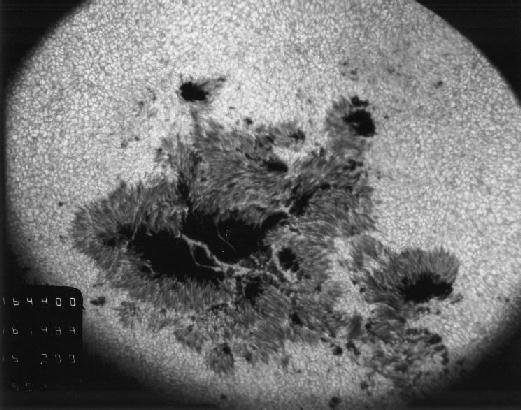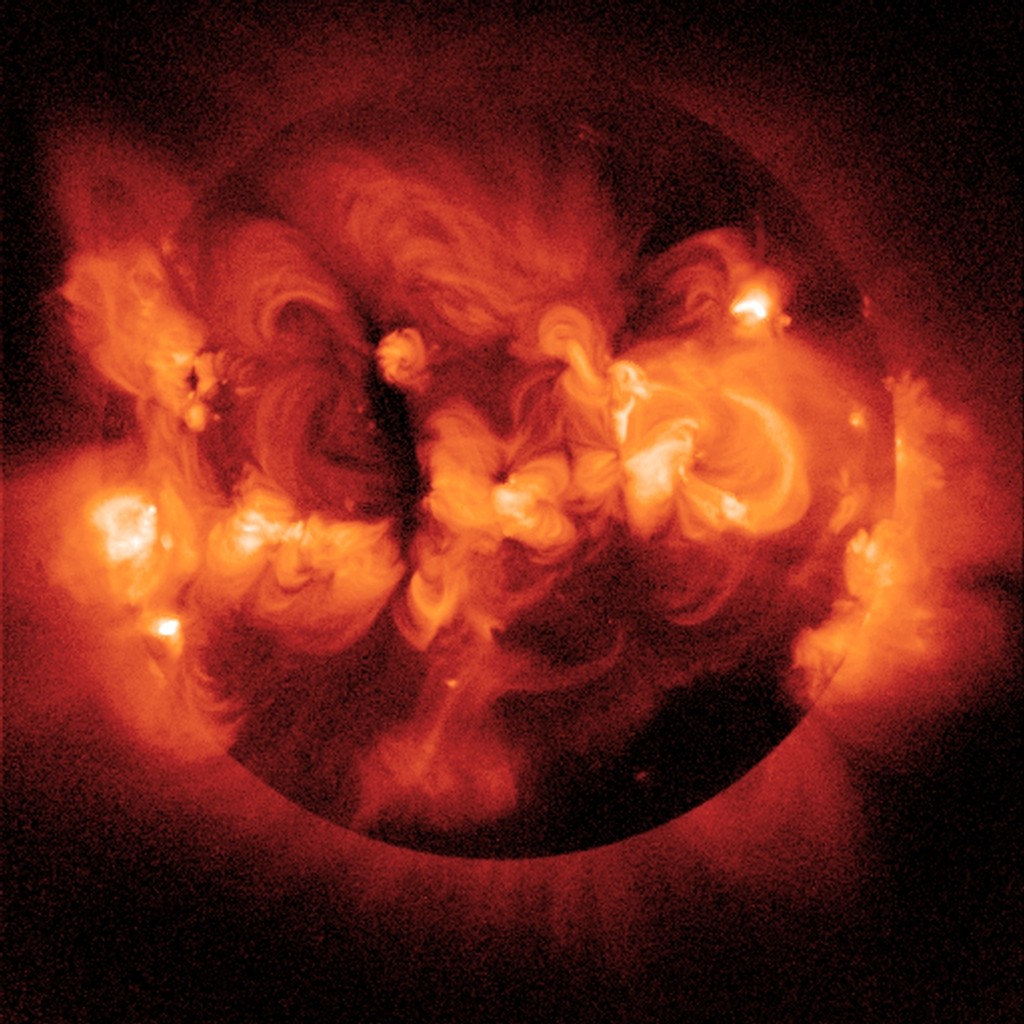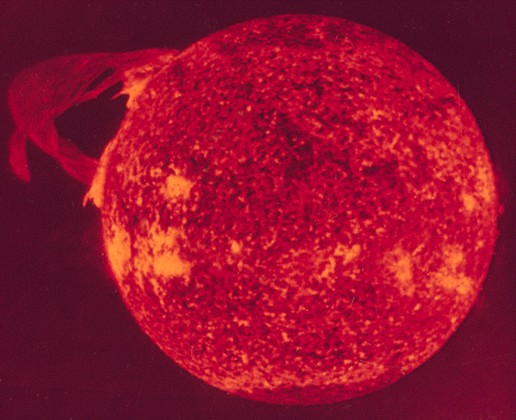The Birkeland Solar Model: EU Theory And The Plasma Layers Of The Sun
This is an informal manuscript of the solid surface model
of the sun that is based on electric universe theory and has been offered for general web
peer review. It includes a more formal presentation of this
solar model material. A larger file in Microsoft Word is also available
to describe this solar model. The electrical aspects of this model of the
sun
have also been presented in the
Journal Of
Fusion Energy in a more formal and published presentation.
My Deep Gratitude To Everyone Involved In The
HUBBLE, Yohkoh, Hinode, SOHO, Trace, STEREO, RHESSI, Geos, Chandra And Spitzer, and other satellite Programs.
I have more recently added content from the Hinode and Stereo satellite programs
which tend to fully support the data from previous satellite missions.
The sun is the "Rosetta Stone" of astronomy. Observing, understanding and
explaining the inner workings of our own sun is the key to unraveling the
mysteries of the physical and quantum universe that surrounds us. The only way to know if we have properly deciphered the stone and to confirm that
we have
discovered the correct model is to use this model to explain the observed behaviors of
the sun, and where possible to "simulate" these properties here on earth.
For four centuries Galileo's gas model of the sun has
consistently failed to explain or simulate many of the key observational pieces of evidence from our own sun.
For instance, it has failed to explain the million degree heat source of the solar
corona, the outer most layer of the sun. I has failed to explain the cause of
coronal mass ejections, solar flares and many other observed and well documented solar
phenomenon. Even the idea of sustained fusion has eluded us here on earth
in the lab.
On the other hand, the solar model that Dr.
Kristian Birkeland experimented with in his lab in the early 1900's can easily explain
these key observations. Birkeland himself even personally simulated most
of the key observation in a lab over 100 years ago. His experiments in
electric universe theory can reveal the keys to unraveling the many
mysteries of the sun.
The reason for the current confusion in gas model circles is simple. The
STEREO, SOHO, TRACE and YOHKOH satellites
have all demonstrated that the sun is not simply a giant ball of gas as Galileo
first believed
based on his limited observations through a primitive telescope. Just as Dr.
Birkeland predicted, the sun has
a solid, electrically conductive surface that is composed of iron ferrites and
Nickel composites, and sits beneath the
liquid-like plasma layer of the photosphere which can be observed in solar
satellite images from many satellite programs. The sun has a solid and
electrically conductive crust that is covered by a series of mass separated plasma layers,
starting with calcium, silicon, neon, helium and finally a layer of hydrogen that
ultimately ignites in the corona. This solid surface model of the sun that
Dr.
Birkeland experimented with in his lab, can
and does explain many of the observed behaviors of our own sun quite elegantly and Birkeland's solar model offers us the
best hope of deciphering the stone (in this case iron ferrite) tablet that will
help us unlock the mysteries of our universe.
The following theories are based on concepts that came from downloading,
observing
and analyzing
gigabytes worth of "raw EIT" and other types of SOHO and TRACE videos over many months,
and actively viewing TRACE SOHO, and YOHKOH satellite images and other videos
and photos of the sun over many years. It is also based in large part on
the work of Dr. Kristian Birkeland, Dr. Charles Bruce, and Dr. Oliver Manuel.
These scientists have compelling new evidence to support their case in the form
of satellite observation. Please
keep in mind that I am not affiliated with the SOHO, Trace, Yohkoh, Rhessi,
or Geos programs in any way but
I am most grateful for the research they have provided to the general public and
to amateur astronomers like me.
I have provided quite a bit of video and JPG files on
this website from many satellite images to fully support the ideas I am presenting, but by no means have I provided all the video
that is available through the Rhessi, Geos,
YOHKOH, SOHO's
or TRACE websites. These
kinds of groundbreaking technologies set the stage for significant scientific
breakthroughs. This is the kind of cutting edge scientific research that makes new
ideas possible in my opinion. My heartfelt thanks to all the hard work and
dedication on the part of the Geos, Rhessi, Yohkoh, SOHO and Trace teams.
Most especially, my heartfelt thanks to my good friend, Dr. Oliver Manuel for
all his hard work and support.
To fully experience this website, you'll need a high speed internet connection,
Windows Media Player and the Apple Quicktime player. This website is optimized for a
display resolution of 1024x768 pixels or better. If you click on the colored
(underlined) links,
they will open up videos or animations related to the idea being discussed.
Some links can be up to 20 megabytes in size.
The Fatal Flaw In
The Old Model
Why do we need a new model of the sun? To appreciate what's wrong with the
current gas model of the sun, we need to look back at history, and see how the
old (gas) model of the sun came to exist, and how these early ideas influenced
later research. We also need to take a fresh look at some of the ideas
that Dr. Kristian Birkeland discovered at the turn of the 20th century especially now
that his theories have been verified by satellite observations and are
corroborated by enormous amounts of satellite imagery.
Galileo lived in the 16th century and was one of astronomy's early pioneers.
He made his observations of the sun using a common and very primitive telescope
by today's standards. Back then of course it was "state of the art
technology". Galileo
eventually went blind, no doubt at least in part from looking directly at the
sun.
Fortunately you can see what
Galileo saw without any risk of injury to your eyes thanks to Tom Bridgman from Stanford
University.
What Galileo OBSERVED with his eyes was not the surface of the sun at all, but
only the surface of a dense plasma layer called the
photosphere that covers the
surface of the sun (2nd image on the right). What Galileo could NOT see
with his eyes are sophisticated running difference and Doppler images of the sun
from the SOHO satellite such as the 3rd grey image you see on the right, or
these running difference images of the solar
surface observed by the TRACE satellite at 171 angstroms.
Galileo observed that sunspots in the photosphere changed over time, and the
rotation speed of the photosphere at the equator was different than the rotation
speed at the poles. From this behavior he surmised that he must be looking
at a gas-like substance. He was right about that part although we know
today that the photosphere is composed of dense plasma.
Unfortunately Galileo also simply ASSUMED that nothing solid existed or could
exist beneath this layer of the photosphere. That assumption was a
critical mistake. That's a bit like looking at a world covered by
water and not having the ability to look beneath the surface of the water and
simply assuming that the whole planet must be made of water, with more "densely
packed water" at the core. In order to VERIFY what Galileo simply
ASSUMED, we must TEST his theory and look for ways to look beneath the layer of
the photosphere. Galileo never had such an ability during his lifetime.
Thanks to very sophisticated imaging techniques
equipment on board the Yohkoh, SOHO and TRACE satellites, that is no longer the case.
In short, Galileo was limited to what his eyes could observe, whereas today we
have the ability to peer beneath the layer that Galileo saw with his eyes, and
observe the solid SURFACE of the sun that lies beneath the photosphere.
Today we can look at the sun across a large spectrum of various wavelengths that
no human eyes could ever hope to see.
If you notice from
these running difference images from SOHO using a 195 angstrom filter, the actual surface of the sun
does not rotate at different speeds near the equator than it does at the poles like
the photosphere. It acts FAR more like a solid, than a gas. If
Galileo had access to these kinds of satellite images and videos, he probably would have come up with
quite a different concept about makeup of the sun, probably one much like Dr.
Birkeland presented several hundred years later. The critical thing to
notice here between these different videos is that Galileo's entire perspective was
limited by what he could could OBSERVE with very limited technology in a very
narrow wavelength range. The running difference images from SOHO show a UNIFORMLY
rotating and SOLID surface, whereas the images of the photosphere show that the
photosphere is moving plasma, and behaves very differently from the surface of the sun itself.
For the next 400 years, gas model theorists have tried to understand the sun and
create models of the sun that were based on Galileo's early assumptions and
early framework. They diligently measured the plasma layer of the photosphere in a
variety of ways and have in fact verified Galileo's prediction about the moving
nature of the gas/plasma photosphere. It's a gooey plasma layer to be sure.
Gas model theorists have built
very sophisticated models based on shear forces caused by the uneven movement of
the photosphere. These things have in fact been verified.
There is a problem however with gas model theory, and it begins at .995R, or
just under the
visible photosphere. At this depth, contemporary gas model theory runs
headlong into a
stratification layer, a layer of solid material where sound waves begin to
travel faster than they travel through plasma. This is a layer that holds
the three dimensional shapes like we see in the gold image on the right.
These structures are visible over timeframes of many hours. Only through
surface erosion do these structures ultimately begin to change. The change
recorded in this stratification layer is very unlike the changes seen at the
surface of the photosphere where granules are created and destroyed
every eight minutes.
Gas model theorists have tried unsuccessfully to understand solar events based
on a basic ASSUMPTION that had never been tested and was critically flawed.
In the mean time however newer ideas and newer models have emerged, most
importantly the solid surface model of the sun first proposed by Dr. Kristian
Birkeland at the beginning of the 20th century.
Only in the last 10 years (a virtual blink of an eye in scientific terms) have
we had access to information and technology that could verify or refute various models
of the sun. The information that Rhessi, SOHO and Trace and Yohkoh offer us today however sticks out
like a gigantic sore thumb in the gas model theory, and provides very compelling
evidence to suggest that Galileo was quite wrong in his assumption that no
solids existed under the photosphere. Modern satellite images lend strong support to Dr. Birkeland's electrically conductive,
solid surface model of the sun. In fact, many of the image that Birkeland
produced in his lab in the 20th century have 21st century satellite image counterparts.
The uniform movement of this iron layer of the sun suggests that we
must boldly rethink our views about the sun, and the universe we live in and
come up with new models that explain the observations that new technology from
the SOHO, Rhessi, Geos, Yohkoh and TRACE satellites lay before us.
The Surface Of The Sun
Based on running difference imaging techniques, SOHO has demonstrated that the
the sun has a solid, electrically conductive,
ferrite surface, just below the observable photosphere
which
rotates uniformly every 27.3 days. The uniformity of this movement is
unlike anything we find in the photosphere. It's rigid. It moves
UNIFORMLY from equator to pole. It is being dynamically reshaped and
eroded by continual
electrical arcing between
magnetically
polarized points
along the surface. These arcs emit light consistent with a number of iron
ferrite ions, suggesting this surface is composed of ferrite based materials. This
electrical erosion process continually eats away at the surface like an arc
welder melts the ends of a welding rod and the surface where the arc touches.
Eventually the surface is
melted
away, sometimes along very long "fault lines" ultimately resulting in
cracks along the surface and "sunquakes".
Sometimes these resulting sunquakes release massive solar tsunamis that are visible across the sun's
photosphere
and result in enormous coronal ejections
and
massive prominence eruptions such as this one on June 28th 1945.
The erosion caused by this constant electrical arcing between points along the surface is at least one of the catalysts for the sun's
ever changing sunspots. The electrical discharge process also releases massive
amounts of heat into the liquid-like plasma of
the photosphere that covers the surface,
creating the granular patterns that we see
on the surface of the photosphere. Other plasmas
builds up over time in the "taffy-like atmosphere" of the photosphere and
collects near the sun's surface, much like a heavier
liquid sits at the bottom of a lava lamp until heated. Eventually it
collects together and is ejected in a surface eruption toward the edge of the
sun's liquid-like chromosphere where it ultimately explodes in massive coronal ejections.
The Arc
One of the most basic processes of the sun is the
electrical arc. The sun's inner fission reactions act as a battery, releasing
free protons and electrons, while the surface acts as a giant conductor.
As these streams of electrons reach the surface, they ionize
ferrite at the surface, pushing it into the silicon layer of the photosphere,
which in turn insulates the electrical flow to create giant electrical arcs between
surface features. The neon layer acts as a giant discharge lamp, emitting and adsorbing electrons. As the flow of energy (-)
from the outside space passes through the atmosphere of the sun, it also seeks
orientation along LOCAL magnetic alignments that run through the surface crust.
The LOCAL magnetic orientation at the very top of the surface crust is based
upon the electrical flow, and magnetic orientation of the energy flow that
occurred as that part of the sun's surface cooled. As upper surface
crust is eroded, lower areas of the crust are revealed and exposed to the
surface. If enough arcing occurs in one area, cracks can form at the
surface, with resulting solar quakes and/or solar flares. The surface
"crust" is aligned and oriented along the electrical flow lines and take on a
magnetic orientation and a set of alignment properties that existed as that
part of the crust cooled. That specific surface orientation, and
the magnetic orientation of the suns core causes electrons to flow through
surface structures. The actual surface and deeper crust alignments
will determine the flow of electrons passing through it, and/or the potential
for electrons to pass through it. When the magnetic poles of the core
point toward the equator, these are times of intense magnetic storms and
massive sunspot activity. As the magnetic alignment of the core aligns
with the spin axis of the sun, we get "quiet" periods, where sunspot activity
decreases. The sun takes 22 years to complete one turn in it's magnetic
rotation, resulting in increased sunspot activity every eleven years.
This constant arcing and constantly changing
magnetic orientation of the core creates a very dynamic erosion process, and
creates very uneven
surfaces over time. These uneven surface structures lead to an uneven distribution of energy at various
surface points. The sun's inner fission reactions act as a huge,
seemingly infinite, fission battery while the surface acts as a giant discharge lamp,
with the core constantly releasing protons and protons and the surface is constantly emitting
and adsorbing electrons. The surface points become positively and
negatively charged based on the flow of these free protons and electrons and
the magnetic alignment of the core and the magnetic alignment and structure of
the crust.
As free flowing electrons pass through the photosphere from various surface
points and also from space itself, they are attracted to, and "arc" toward,
any surface structure that is positively charged. These energy flows
create the spectacular electrical arcs through the photosphere right up
through the chromosphere and well into the corona such as we see in the images
to the right.
An electrical arc forms between two oppositely
aligned (charged) magnetic surface points. The intensity of the arc will
depend upon the quantity of energy flowing through them at the time.
Electrons and protons are constantly being released by sun's inner fission reactions. These
free flowing particles are attracted to magnetically aligned "highways" that
run through the surface of the sun from the ever rotating magnetic core. Electrons from space, and from the
surface of the sun itself, are
immediately attracted toward oppositely aligned (positively charged)
structures on the surface and an electrical "arc" is formed.
The Photosphere
The photosphere is certainly one of it's
most enigmatic and
misunderstood layers of the sun. It is commonly, and quite mistakenly,
referred to as the "surface" of the sun. It is not the surface of the sun
at all. It is a liquid-like neon plasma layer more commonly referred to as
penumbral filaments.
This neon filament layer conducts heat to the surface. Neon not only produces
the light we see, it also is used as a cryogenic refrigerant which is the
primary reason a solid surface can form beneath it.
Underneath this neon layer is a gooey layer of silicon which insulates the arcs,
and crusty plasma layer of calcium underneath, right along the ferrite surface.
The silicon layer in the photograph on the right does not shine like the neon,
but the neon layer above them does shine, producing the light we see. Far
below both the neon plasma and the silicon plasma sits the dark black calcium
ferrite layer of the sun, with a visible crack in the surface. The heat
from that surface crack pushed the silicon layer up through the neon layer till
it hits the helium layer of the chromosphere and gravity takes over and
pulls the silicon layer back down. Once the surface cools off, the silicon
in that area will stop rising and the neon layer will rush in to cover up the
hole
The penumbral filaments are responsible for the granular
convection patterns of the photosphere and produce the light we see with our
eyes. That is because this layer is composed of neon, like the neon
in an office light bulb, and the neon used in cryogenic refrigeration. The liquid-like
silicon plasma OCEAN
of the lower photosphere covers the entire ferrite surface of the sun much like the earth's oceans
cover most of the earth. The energy released in the ever present
electrical arcs
passing through the insulating layer of the photosphere (often through the chromosphere as well), heat
up the the dense
plasmas of the photosphere and the lighter
helium plasma layer of the chromosphere above it. In the presence of large electromagnetic
flows and large amounts of heat, or eruptions from the surface, the clear
silicon plasma
in the lower regions of the photosphere rise to the surface and push through the
neon layer of penumbral filaments, forming
visible "holes" or sunspots in the photosphere.
Once the surface crust of the sun "cools off", the hot silicon plasma
below the neon layer stops
rising as fast, the gooey neon layer of the
photosphere reforms and closes back up, and the sunspot disappears.
The electrical discharge of the sun may be responsible for at least some if not
all of the sun's overall electrical output. Without a doubt, this
electrical arcing releases huge amounts of energy. The starting and ending points of the arc are not random in
any way, but are directly related to the magnetic orientation of the surface points
themselves and therefore the electrical charge and the electrical flow of energy from the core itself.
As these arcs heat up the
liquid-like silicon plasma of the photosphere, that heat is "boiled" to the surface of
the photosphere, the neon plasma layer. Normally this neon plasma layer
simply cools the silicon layer through penumbral filaments in the familiar
granular patterns we see. When
the silicon layer gets very hot, it pushes through this layer and into the
helium layer, where gravity quickly takes over. The surface below is
cooled by the cooler surrounding silicon plasmas that rushes into the rising
plasma column.
Another kind of plasma (perhaps extra calcium or nickel) eventually builds up and collects along the surface of the sun. It
collects between the surface and the silicon layer of the photosphere. It can sometimes rise up
through the photosphere when heated much like a heavier liquid in a lava lamp
rises when it's heated.
It seems to collect more often near the poles than the equator. Often this
plasma is "pushed" by a surface eruption of some kind.
This build up of mystery plasma is eventually ejected into
space, often triggered by a surface fracture (notice the top right hand corner
of the video). When
this liquid-like "blob" reaches the boundary of the chromosphere and
the corona
it picks up huge amounts of heat and causing quite spectacular coronal discharges. Nickel and sulfur
are typically found in the sun's output during quiet phases, so perhaps this
mystery layer is nickel since it appears to come from beneath the silicon layer,
suggesting it's heavier than silicon, and heavy enough to "pool" on the surface.
The sun's magnetic poles rotate one full cycle over a 22 year time frame.
It's possible that the sun itself simply rotates around a fixed universal magnetic field every
22 years, or is influenced by an external electromagnetic field that rotates
every 22 years. Such a universal magnetic field may be responsible for the
acceleration of the universe itself and perhaps even "gravity" as we understand it.
Every 11
years, the magnetic poles of the sun point toward the equator. When this
happens, the electromagnetic flow at the equator becomes much stronger, more
violent, and more energetic patterns emerge as the surface and heat up the
silicon which rises in a column. This rising silicon leaves gaping holes in the
neon layer of the photosphere. This increased electrical activity is particularly
strong when the magnetic poles points SLIGHTLY north and south of the equator.
This creates highly polarized, oppositely charged surface structures just
north and south of the equator. From these magnetically polarized surfaces
pour HUGE rivers of energy flows which jump from one range of surfaces on one
side of the equator, toward an oppositely aligned structure on the other side of
the equator. When the magnetic poles are more or less parallel to the
equator many more sunspots appear in the photosphere and a greater number of
corresponding sunspots appear in the photosphere as the liquid like silicon plasma of
the photosphere rises quickly to the surface of the neon layer, where the photosphere meets the
hydrogen chromosphere. The rising silicon in the photosphere pushes through the neon
penumbral filament
layer
at the top of the photosphere, opening up gaping holes in the penumbral
filament layer. The neon layer of the part o the sun that actually
"shines" in visible wavelengths and cools the surface below.
Contact us for more info
|
